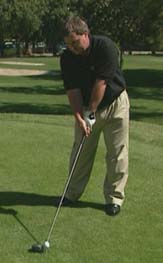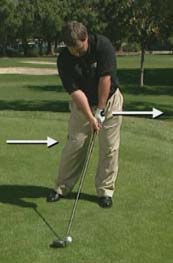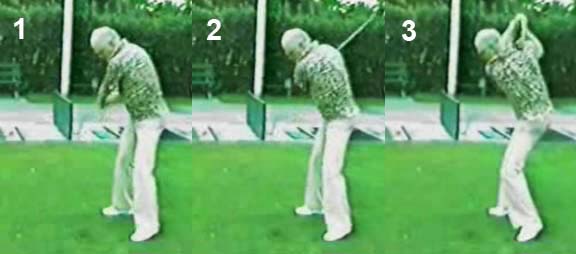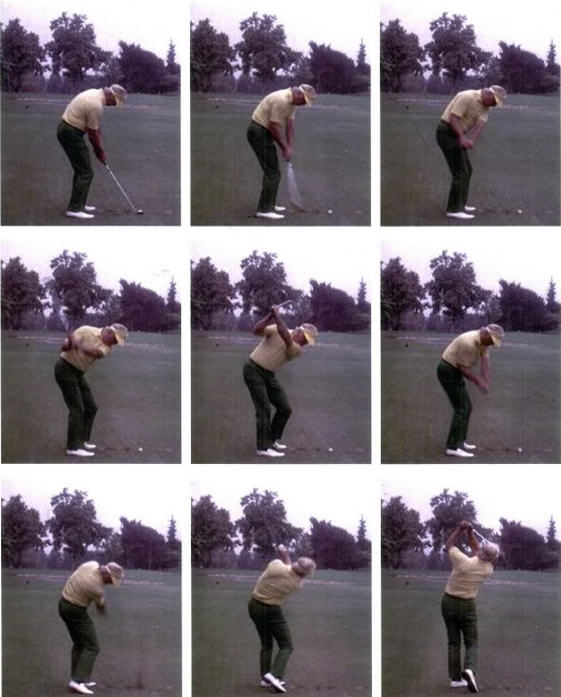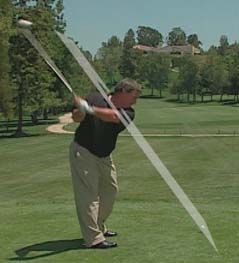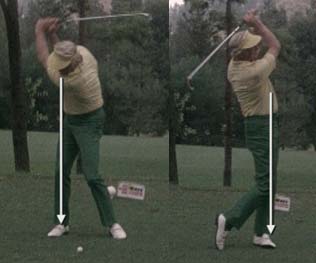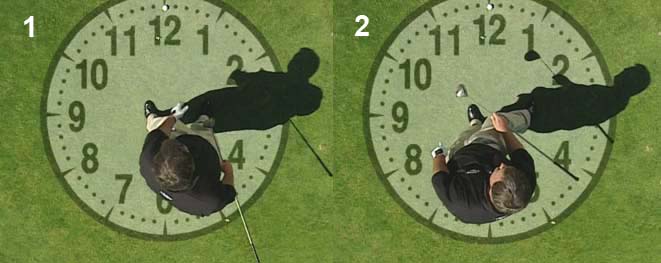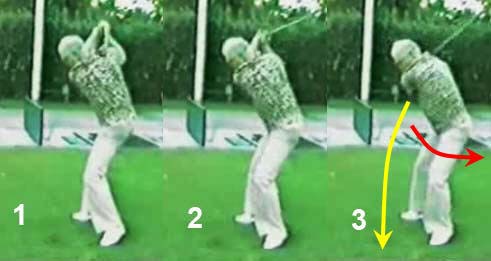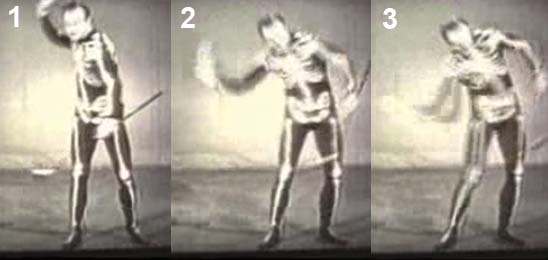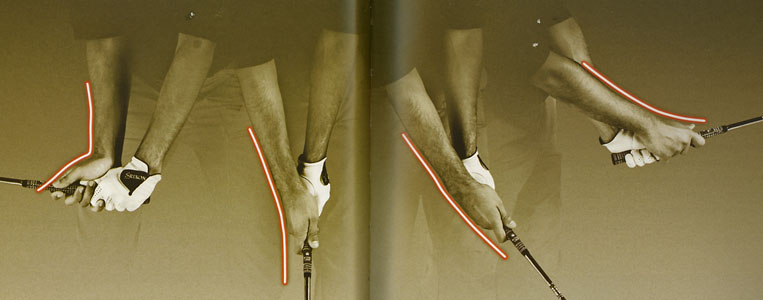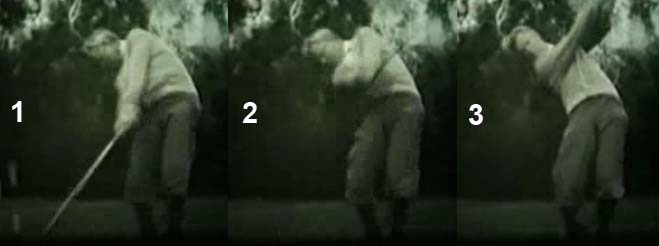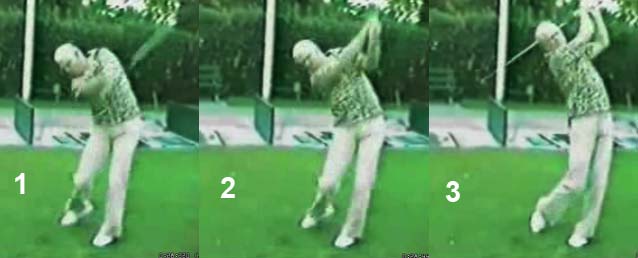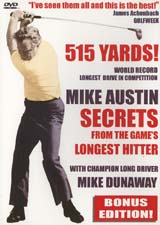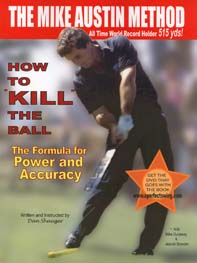Critical Review : Mike Austin's Swing Methodology
Click here to go back to the index page.
Introduction:
In this review paper, I will be discussing Mike Austin's swing methodology. I have received a number of requests from website visitors asking me to write about Mike Austin's swing methodology, and I finally decided to respond to that request. Who is Mike Austin? Mike Austin - who died at the age of 95 in November 2005 [1] - is well known to the world of long-drive competitors, because he holds the Guiness World Record for the longest drive ever recorded in competitive play. He hit a 515 yards drive (in the presence of a 35mph tail wind) while competing at the age of 64 years [2]. He was well known to be capable of hitting long drives, and he was still hitting drives >300 yards in his late 70s (just prior to being incapacitated by a major stroke). Although he could not continue to play golf after his massive stroke, he continued to give lessons, and some golfers reputedly paid $10,000 for a weekend of golf instruction. He developed a cult following and he also acquired many disciples who still work diligently to promote, and teach, his swing secrets. The most reknown Austin-protege is probably Mike Dunaway, who also became a successful long drive competitor. Mike Dunaway produced a golf instructional DVD regarding Mike Austin's swing methodology [3], and Mike Austin, who was in attendance during the production of the swing video lesson, offered a number of supplementary verbal comments. I will be primarily reviewing Mike Dunaway's DVD in this review paper - in my usual scholarly manner - and I will personally dissect Mike Dunaway's teaching approach so that readers can hopefully benefit from my (biased) golf instructional opinions. I also read another book on Mike Austin's swing methodology, which was written by Dan Shauger [4], but I personally believe that his descriptive approach reflects certain personal biases that may not legitimately represent the reality of Mike Austin's swing style, and I will not be discussing any of his personal thoughts on Mike Austin's swing methodology in this review paper.
In this review paper, I will be critically analysing Mike Dunaway's description of Mike Austin's swing methodology, and I will be arbitrarily providing a number of alternative biomechanical/mechanical explanations that are based on my personal observation of many Mike Austin swing videos. This review paper should not be perceived to be an impartial description of Mike Austin's swing methodology, but rather a critical review based on the author's personal (biased) approach to understanding/describing golf swing mechanics/biomechanics. My descriptive approach is significantly influenced by TGM-concepts that I have learnt from Homer Kelley's TGM book [5], and biomechanical concepts that I have learnt from my medical school training.
Mike Austin's swing methodology - as presented by Mike Dunaway, and as re-interpreted by the author
I am going to describe Mike Austin's swing in the order that Mike Dunaway presented his description in his DVD [3]. The amount of detail that I will provide will be affected by the importance of the specific swing feature to the efficiency of Mike Austin's swing, and I will not spend much time discussing minor swing elements. In the DVD, Mike Dunaway is the golfer-model, while the elderly, stroke-incapacitated Mike Austin sat in a director's chair, and watched the demonstration. Mike Austin intermittently made verbal comments to supplement Mike Dunaway's visual demonstrations and verbal descriptions.
Grip
Mike Dunaway starts off by describing Mike Austin's grip. Mike Austin had a neutral grip with no unusual features and I do not need to make additional comments.
Address position
Mike Dunaway describes how Mike Austin adopted his address posture and distance from the ball. Mike Austin started off by holding the left arm and the clubshaft in a straight line relationship (in the air opposite, and in front of, the left shoulder) and he then let the weight of the club establish the power accumulator #3 angle (angle between the clubshaft and the left arm). Mike then stood with his legs straight, and bent from the hips, thereby lowering the club until the clubhead reached the ground - that established the distance of his club from his body. He then relaxed the knees slightly to acquire his address posture where his knees, thighs, pelvis and shoulders are all parallel to the ball-target line. Because the right hand is lower on the grip than the left hand, he had to develop a method of acquiring rightwards spinal tilt, which lowers the right shoulder socket. Mike Austin's method was to kick-in the right knee slightly, which slightly lowers the right pelvis. This helps to create rightwards spinal tilt. This method is very similar to my personal approach - where I shift the pelvis slightly to the left at address, and this maneuver causes the left leg to become slightly straighter than the right leg.
Mike Dunaway at address - capture image from his DVD [3]
Note that Mike Dunaway has kicked-in his right knee, which causes the pelvis to have a small degree of tilt due to lowering of the right pelvis. That allows him to more easily acquire a small degree of rightwards spinal tilt and it also allows him to get his head behind the ball. Note that his pelvis has shifted slightly leftwards during this maneuver.Note that Mike Dunaway has only a small amount of knee flex, and that he stands fairly erect. Note that his hands and clubshaft are relatively centralised between his legs (TGM adjusted address position) which causes his left wrist to become slightly bent.
I think that there is nothing unusual about this address posture, and it is fully compatible with the traditional/conventional golf swing.
Takeaway and backswing action
Mike Austin recommended a forward press to start the takeaway.
Mike Dunaway demonstrating a forward press - capture image from his DVD [3]
When performing a forward press, a golfer pushes forward on the grip end of the club while keeping the clubhead stationary. This maneuver flattens the left wrist and increasingly dorsiflexes the right wrist. This maneuver may also help a golfer start the takeaway action more smoothly. I regard the forward press as an optional golf swing element, and I do not think that it should be deemed to be a mandatory action - because during the standard takeaway the left wrist becomes naturally flattened as the right wrist increasingly dorsiflexes (thereby establishing the correct alignment of the left arm flying wedge). During the forward press, Mike Dunaway also presses forward simultaneously with the right knee against the resistance of the braced left leg.After performing the forward press, Mike Austin started the takeaway by moving the left arm back while allowing the left upper arm to internally rotate in the left shoulder socket. This allows the club to swivel so that he can get the clubshaft onto the inclined plane by the mid-backswing. When taking the left arm back, Mike Austin kept the left arm somewhat connected to the rotating upper torso, and this caused his clubshaft to move slightly inside by the end of the takeaway.
You can see how Mike Austin's clubhead path moves slightly inside during his backswing in this swing video - http://www.youtube.com/watch?v=zc5ufM1MW1o
Mike Austin's inside takeaway - capture images from his swing video
Note that Mike Austin's clubshaft is slightly inside (and not parallel to the ball-target line) at the end-takeaway position (image 1 - his clubhead is the white dot that is just inside his left forearm). Note that as he continues to rotate his shoulders during the backswing, that his left arm becomes slightly higher than the shoulder turn angle (which is relatively horizontal) by the end of his backswing (image 3).One can see the same inside-takeaway phenomenon in the following sequence of Mike Austin photos.
Mike Austin backswing and downswing sequence - capture images from a swing video
There is nothing unusual about having a slightly inside takeaway, which causes the hands to get slightly deeper (away from the ball-target line) during the mid-backswing (image 4). If the hands get too deep, it is possible to get "stuck" later in the mid-backswing when the hands cannot move further away from the ball-target line, and this situation forces a golfer to then lift the arms in the late backswing (which can subsequently predispose to an OTT move). However, this doesn't happen in Mike Austin's backswing, and his hands/clubshaft move in a continuous/smooth arc to his end-backswing position. His clubshaft crosses the line slightly at his end-backswing position - as a consequence of his inside takeaway action.
Note that the toe of Mike Austin's clubhead is facing upwards at the end-takeaway position (seen as a blur in image 3) and that the back of his FLW is nearly parallel to the ball-target line. This happens naturally when a golfer employs a takeaway swivel action (which I described in detail in my backswing chapter and other review papers). In all the swing videos of Mike Austin that I have viewed [6], he always employed a takeaway swivel action that gets the back of his geometrically FLW, and therefore clubface, parallel to the inclined plane by the mid-backswing (image 4). Some Mike Austin disciples claim that Mike Austin changed his approach later in his life, and that he recommended keeping the clubface more closed to the clubhead arc during the takeaway action by counter-rotating his left arm (a maneuver recommended by Dan Shauger in his teaching of Mike Austin's swing methodology). To understand this counter-rotation movement of the left forearm - see my description of the "twistaway maneuver" in question number 3 in my backswing chapter. If you are interested in reading more about this particular Mike Austin swing methodology controversy - see this golf discussion forum thread [8] or read this webpage's description of Mike Austin's hand action [9]. Jaacob Bowden claims that Mike Austin used the standard rolling hand-action (takeaway swivel action) throughout his career, and that he only considered the possibility of using a "twistaway maneuver" after his stroke. I personally do not favor a twistaway maneuver for a golfer who is a swinger, and Mike Austin was quintessentially a swinger, who would naturally use a takeaway swivel action to get his intact left arm flying wedge onto the inclined plane by the mid-backswing.
In his DVD, Mike Dunaway also describes how Mike Austin gets his clubshaft on the "correct" swingplane during the backswing action. His description is very rudimentary (by my standards) and he relates it to Ben Hogan's glass pane swingplane concept.
Mike Dunaway in mid-backswing - capture image from his DVD [3]
In this image, Mike Dunaway has Ben Hogan's imaginary plane of glass resting on his shoulders. I think that using Ben Hogan's glass pane concept is of no use when trying to understand the swingplane concept, and interested readers should read my review paper on the Swingplane if they want to better understand the swingplane concept. Mike Dunaway uses a standard backswing action where the clubshaft moves from the hand plane to just above the TSP by the end of his backswing. At this mid-backswing position (when his left arm is parallel to the ground) his clubshaft is just above the elbow plane. Note that he has a geometrically FLW and note that his left arm flying wedge is intact, and his clubshaft is roughly "on-plane" (butt end of the club is nearly pointing at the ball-target line). There is nothing unusual about Mike Dunaway/Austin's arm/clubshaft movements during the backswing, and it is fully compatible with a TGM swinger's backswing action (which I have described in detail in my backswing chapter).Mike Austin's compound pivot action
Mike Austin's compound pivot is regarded by many Mike Austin fans as one of his major secrets, but I actually believe that his pelvic action is very traditional.
In the DVD, Mike Austin stated that he went from a two foot balance at address (where his weight was equally distributed between his feet) to a right foot balance at the end-backswing (where most of his weight is over his right foot) to a left foot balance at his finish (where most of his weight is over his left foot).
Mike Austin - capture images from the DVD [3]
Image 1 shows Mike Austin at his end-backswing position and the white arrow implies that most of his weight is over his right foot, and image 2 shows Mike Austin at his finish and the white arrow implies that most of his weight is over his left foot.Mike Austin believed that the weight transfer was primarily due to his pelvic (lower body) pivot action, because he kept his head (and therefore upper swing center) stationary throughout his backswing and downswing.
Mike Dunaway/Mike Austin described the compound pelvic action in the following manner in his DVD. He used a clock analogy to explain the pelvic movement in the backswing and downswing.
Mike Dunaway demonstrating the compound pivot action - capture images from his DVD [3]
At address, Mike Dunaway's body is parallel to the ball-target line and situated between 9-to-3 on the clock. He is standing erect during this demonstration. The backswing pelvic action involves a lateral movement of the pelvis to the right while straightening the right leg, and this causes his weight to move to 4 o'clock (image 1). That creates a "feel" of right foot balance. During this process, the left knee becomes more bent. To start the downswing, he kicks-in his right knee towards 10 o'clock and shifts the right pelvis in the direction of 10 o'clock, while straightening the left leg. At impact (represented by image 2) he has an open pelvis, and his left leg is straight while his right knee is bent. Note that his head, and therefore upper swing center, remains stationary during this compound pelvic action, and most of the body motion involves a shift-rotation movement of the pelvis and lower spine.In the DVD, Mike Austin stated that his pelvis moves up-and-down before rotating. I presume that he means that his right pelvis lifts up as he straightens his right leg during the backswing, and then his right buttocks rotates back-and-around towards the tush line. Then during the downswing pelvic action, the left pelvis lifts up as the left leg straightens, followed by a rotation of the left buttock back-and-around towards the tush line. Mike Austin calls this dual pelvic motion (which involves lateral pelvic and rotational pelvic motions) as a compound action.
I actually believe that this compound pelvic action is the same pelvic action that I have described in my downswing chapter and in my The Backswing and Downswing Hip Pivot Movements: Their Critical Role in the Golf Swing review paper - although I have described it differently.
If you look at Mike Austin's backswing pelvic action, you will note that he still keeps a lot of flex in his right knee, and he doesn't allow the right knee/thigh to sway to the right. As he shifts to a right foot balance, he is essentially shifting to the right against a braced right leg (that straightens slightly), and that causes his right buttocks to move back to the tush line and also around to the left. In the downswing, he actually starts his downswing pelvic action with a "left hip clearing action" where the left buttocks gets pulled back to the tush line, while the right buttocks remains close to the tush line. He may have a "feel" sensation of pushing the right pelvis towards 10 o'clock, but the reality is that the left pelvis gets pulled back to the tush line more than the right pelvis leaves the tush line - in the early downswing. You can see this phenomenon in all his swing videos.
Mike Austin's pelvic action in the early downswing - capture images fom his swing video [6]
At the start of the downswing, Mike Austin pulls his left buttocks back to the tush line while keeping the right buttocks close to the tush line (where it was positioned at the end-backswing position) - and this represents the "left hip clearing action" described by Ben Hogan. The reason why the left buttocks moves more than the right buttocks is due to the fact that the left femoral head (and therefore left pelvis) is relatively unweighted and there is no impedance to its motion in space, while the right femoral head (and right pelvis) is markedly weighted, and they therefore resist motion. Image 4 shows the end of the "hip squaring phase" where the pelvis is relatively square to the ball-target line, and the pelvis has already rotated about 45 degrees to get to this position. During the remainder of the downswing, the pelvis will continue to rotate against the resistance of an increasingly straightening/braced left leg. It is only in the late downswing, that the right pelvis moves around towards the 10 o'clock position. If the right pelvis moved forward prematurely in the early downswing, then that would predispose to hip spinning, and a golfer would also have a tendency to fall forward towards the toes of his feet and become unbalanced. I believe that the "left hip clearing action" (while keeping the right pelvis back against the tush line) helps to keep a golfer in balance during the club slotting phase of the early-mid downswing (slotting of the power package phase).
Mike Austin's early downswing - capture images from his swing video [6]
During the early-mid downswing, Mike Austin is pulling/pushing his intact power package down-and-out-and-forwards in the direction of the ball - represented by the yellow curved arrow. At the same time, he is pulling his left pelvis back and around to the left - represented by the curved red arrow. The movement of the left pelvis to the left-of-the-ball-target line is called the "counterfall" (David Lee-originated term) and it helps to keep a golfer in balance while he is swinging his arms/clubshaft in an initial direction that is directed to the right-of-the-ball-target line.Mike Austin has a wonderfully fluid pelvic action in his downswing, and it is amazing how much secondary axis tilt he develops as he shifts his pelvis around to the left in his early-mid downswing. In the DVD, Mike Dunaway states that one should have the "feeling" of moving one's navel about 16" to the left at the start of the downswing, and that is an excellent mental image for a golfer who is trying to emulate Mike Austin's superb downswing pelvic motion. To see how superbly Mike Austin moves his pelvis at the start of the downswing, a reader-viewer should study his skeleton swing videos - where he demonstrated his swing while wearing his skeleton suit (references 6f and 6g].
Mike Austin in his skeleton suit - capture images from his swing video [6f]
Note how far back Mike Austin's head is positioned at the end-backswing position (image 1). Note how he keeps his head (and therefore upper swing center) stationary during his downswing (images 2 and 3) while shift-rotating his pelvis to the left. Note that his downswing pelvic action produces a large degree of secondary axis tilt. A golfer has to have a lot of spinal flexibility and hip joint flexibility to fluidly perform this "Mike Austin" pelvic action, but a capacity to perform it well will be very useful to a golfer who wants to be a successful long-drive competitor.Mike Austin's right arm throw action
If there is one secret that is significantly responsible for Mike Austin's long driving ability, then it is probably his right arm throw action. Mike Austin called this action "throwing the clubhead at the ball".
To better understand Mike Austin's right arm throw action, lets start with Homer Kelley's idea of a TGM swinging action. In his TGM book [5], Homer Kelley divided golf swings into two types - TGM-swinging (drag-loading) and TGM-hitting (drive-loading). I described these two different types of swing action in great detail in my How to Power the Golf Swing review paper. In TGM swinging (drag loading) a golfer generates swing power by catapulting the left arm down-and-out-and-forward towards impact via a pivot action.
The best example of "pure" left arm swinging that I have seen is demonstrated by this amateur golfer performing a left arm-only swing - http://www.youtube.com/watch?v=uUTk7m5PozQ . That golfer can drive the ball 240 yards with his left arm alone. According to Homer Kelley, a golfer, who is a TGM swinger, should not be pushing on the grip end of the club (drive-loading the club) with the right arm/hand while swinging the club - other than the amount of push-pressure needed to allow the right arm/hand to keep up with the grip end of the club (and left hand, which is pulling the club). Mike Austin obviously rejects this idea and he believes that one must pull-and-push at the same time, and that the right arm must supply a considerable amount of throw (push) power - if one hopes to hit the ball 515 yards! So, how does Mike Austin achieve this goal?
To understand Mike Austin's downswing right arm action, one needs to clearly understand all the biomechanical movements involved in his right arm throw action. Mike Austin believed that a golfer should throw the clubhead at the ball with the right hand - as if one was performing an underhand throw action eg. stone skipping action or baseball underhand throw action. One can see Mike Austin simulating this right arm throw throw action in one of his swing videos [6f - starting at the 1:53 time point].
Mike Austin demonstrating a right arm throw action - capture image from his swing video [6f]
In his right arm throw action, Mike Austin looks like he is performing an underhand throw action - as if he were skipping stones. There are two important points to note with respect to his right arm throw action. Note i) how he leads with his right elbow and maintains a ~90 degree angle in his right elbow during the early-mid phase of the throw action (image 1,2,3) so that his right elbow reaches its pitch location near the right hip area - before the right elbow straightens in the late phase of the throw action. Note ii) how he shifts his pelvis left-laterally while performing the right arm throw action. The left-lateral pelvic shift action creates secondary axis tilt, which allows the right shoulder to move downplane during the right arm throw action - and that allows him to perform an underhand action and get the right elbow down to its pitch location in the 'space' in front of his right hip area. It is critically important to shift the pelvis left-laterally before initiating the right arm throw action - because it allows one to more easily keep the right elbow in front of the right hand. If the pelvis is static and doesn't shift-rotate left-laterally, then the right hand would likely bypass the right elbow in the early phase of the right arm throw action, and one would be performing an overhand throw action, and not an underhand throw action. Mike Austin's right arm throw action is quintessentially an underhand right arm throw action, and not an overhand throw action. Image 1 shows how Mike Austin positions his right hand at the end of the backstroke, so that he can initiate his right arm throw throw from the top of the swing. How does he get his right hand to that position during the backswing?Mike Austin refers to the motion of the right arm in the backswing as a thromboning action. One can picture a thrombone player using the right arm to play the trombone. The motion used to pull back the slide section of the trombone primarily involves a bending (folding) of the right elbow combined with a small degree of internal rotation of the right upper arm. I personally don't like the" tromboning" mental image - because it involves an internal rotation of the right upper arm, while the "correct" motion of the right upper arm in a golfer's backswing is an external rotation. Mike Dunaway demonstrates the "correct" motion of the right upper limb in his DVD presentation - using a toy airplane.
Mike Dunaway demonstrating the movement of the right arm in the backswing - capture images from his DVD [3]
If you watch the motion of the toy airplane, you can get an idea of the required biomechanical actions involving the right upper limb that are needed to move the toy airplane in 3-D space in that manner - i) increased right wrist dorsiflexion while keeping the right wrist level (neither upcocked or downcocked) ; ii) increased bending (folding) of the right elbow; iii) external rotation of the right upper arm in the right shoulder socket (while the right shoulder socket moves backwards and slightly upwards). I have described the identical right upper limb maneuver in a different manner in my How to Move the Arms, Wrists and Hands in the Golf Swing review paper - using the visual imagery of a "right clap hand" action. A golfer can use any type of mental imagery to visualise the "correct" motion that is needed to get the right hand to its end-backswing position - behind, and slightly higher than the right shoulder - as long as it occurs in a biomechanically natural manner, as demonstrated by Mike Dunaway.From its end-backswing position, a golfer should imagine the downswing right arm throw action as being equivalent to a stone skipping action - where one tries to throw the stone from the top in a smooth, continuous motion. A critical biomechanical feature of the right arm throw action is the fact that the right elbow leads the right hand, and the right elbow should reach its *pitch location alongside the right hip area while still maintaining a ~90 degree bend in the right elbow. The right elbow should only straighten in the late downswing - after the clubshaft passes the delivery position (3rd parallel). During the early-mid downswing, the right arm throw action mainly involves an adduction of the right humerus in the right shoulder socket, while the right shoulder moves downplane.
(* To those golfers who are deeply analytical - it should be apparent that it is easier to perform this right arm pitch motion if one uses a takeaway swivel action, and not a twistaway maneuver, during the backswing action - because the right humerus undergoes more external rotation during this backswing action, and that brings the right elbow more under the hands at the end-backswing position. A twistaway maneuver - designed to keep the clubface more closed to the clubhead arc during the backswing - means that there is less external rotation of the right humerus and less internal rotation of the left humerus during the backswing, and this subsequently predisposes to a punch elbow motion, rather than a pitch elbow motion, in the early downswing, and that makes it more difficult to perform an underhand motion, rather than an overhand motion, during the right arm throw action).
Mike Dunaway states that a Mike Austin-style golfer should think of releasing the club at the start of the downswing, and he quotes Jack Nicklaus as stating that "one cannot release the club too soon". A beginner golfer may think that an early release will result in casting (premature straightening of the right elbow and premature straightening of the right wrist), but that will not happen if two conditions are met - i) the golfer actively shift-rotates the pelvis around to the left, which causes the right shoulder to move actively downplane, and ii) the right arm is actively adducted towards the right side of the torso so that the 90 degree right elbow bend is maintained in the early-mid downswing, and the "right elbow leads the hands". If you look at swing videos of Mike Austin's swing, you will notice that he maintains a 90 degree bend in his right elbow throughout the mid-downswing and he only straightens the right elbow in the late downswing.
A beginner golfer may also wonder what's the difference between a right arm throw action and switting. I used the term "switting" in my How to Power the Golf Swing review paper, when I described the biomechanics/mechanics of left arm swinging. A left arm swinger uses his pivot-drive action to catapult his left arm towards impact (release PA#4) and I stated that the left wrist uncocking action (release of PA#2) should occur passively in the mid-late downswing due to a centrifugal action. I also stated that a TGM swinger (left arm swinger) shouldn't attempt to use right arm push-power against the aft side of the grip in the late downswing, because that push-force could interfere with the CF-induced release of the club. However, that admonition doesn't apply to the right arm throw action, where the right arm throw action starts at the beginning of the downswing, and where the throwing right arm moves in perfect synchrony with the swinging left arm. Mike Austin stated that a key fundamental in his swing style is ensuring that there is perfect synchrony between the motions of the right arm and left arm throughout the downswing. While the left arm is swinging down-and-out-and-forward towards impact (secondary to his pivot action), the right arm throw action must be simultaneously evolving, so that the right and left arm motions are perfectly synchronised. To perfect a Mike Austin-style swing, a golfer must be physically capable of perfectly coordinating the right arm throw action with the pivot-induced release of PA#4 (release of the left arm). During the right arm throw action, there will be a sensation of increased push-pressure at PP#1 during the early-mid downswing, but the degree of push-pressure must be perfectly balanced with respect to the left hand's pulling force on the grip (secondary to the pivot-driven left arm swinging motion), so that the grip end of the club is not being pushed forward faster by the right arm than it is being pulled forward by the left arm. Also, in the late downswing, when the club is being released by a centrifugal action that uncocks the left wrist, the right hand must not be pushing on the grip end of the club at PP#3 with a force that interferes with the CF-induced release of the club. When the right forearm paddlewheels into impact in the late downswing, it will be applying a push-force to the aft side of the grip via the right palm, and this push force must be perfectly synchronised with the centrifugal force causing the release of the club. Perfect balance between the left-sided pull force and the right-sided push force at the level of the grip end of the club is a key element of Mike Austin's swing methodology.
Hand release action
Another feature of Mike Austin's swing methodology is the concept of fully releasing the hands through impact.
TGM instructors often instruct their student golfers to maintain a dorsiflexed (bent-back) right wrist through impact to ensure that the left wrist will be flat at impact. In fact, to definitely guarantee a FLW at impact, many TGM instructors recommend keeping the right wrist dorsiflexed throughout the entire followthrough (until both arms are fully straight). Mike Austin believes that this recommendation will decrease swing power, and he recommends an uninhibited hand release action through impact. In other words, although he obviously wants the right wrist to be slightly dorsiflexed at impact (to ensure a FLW at impact), he wants a golfer to allow the right wrist to freely straighten post-impact. This type of hand action through impact is often referred to as a slap-hinge release or a puck release. Nick Bradley coined the term "puck release" in his book [9].
Nick Bradley's puck release - from reference number [9]
Nick Bradley used the term "puck release" to describe the motions of the hands through impact - and he stated that a golfer's hand release action should be similar to that of an ice hockey player hitting a puck. The idea would be to straighten the right wrist through impact, so that the right hand rolls underneath the club (image 3). That action would slightly bend the left wrist, which is not necessarily a problem if it happens post-impact. If it happens prior to impact, then that would be "flipping" and a golfer should never flip the left wrist prior to impact. A puck release can occur actively (if the right wrist actively palmar flexes through impact) or passively (if the right wrist straightens secondary to the freewheeling club pulling the right wrist straight).Mike Austin recommends an uninhibited hand release action through impact, and I cannot personally decide whether his left wrist really bends post-impact (as shown in image 3 in that puck release photo-sequence) or whether his FLW rolls counterclockwise after impact while keeping vertical to the ground (as occurs in a horizontal hinging action). All the swing videos of Mike Austin's swing that I have viewed are too fast, and too indistinct, for me to discern what is precisely happening to Mike Austin's left wrist immediately post-impact. I would need a slow motion video of Mike Austin's swing to discern whether Mike Austin used a puck release action, or not. If he used a puck release action, then it must have been passive (and not active) as the hands/club freewheel through impact.
Followthrough-to-the-finish action
A characteristic feature of Mike Austin's swing is that he keeps his head down until the straightening right arm, and associated club momentum, pulls him up to a full finish.
Mike Austin's followthrough-to-finish action - capture images from his swing video [6]
Note that Mike Austin keeps his head down until his straight right arm is parallel to the ground. Then he lets the momentum of the swinging right arm/club pull him up to a full finish, where both his lower and upper torso face the target. A golfer has to have a lot of spinal flexibility to perform this finish action as fluidly as Mike Austin, and he retained the requisite degree of spinal flexibility into his 70s. Consider his finish action when he was in his 70s'.
Mike Austin's finish action - capture images from his swing video [6]
Note that Mike Austin retained his remarkable degree of spinal flexibility into his 70s and note that he was still physically capable of performing a very fluid finish action. I believe that Mike Austin's spinal flexibility was a major contributing factor to his remarkably fluid swing performance. He kept his head, and therefore upper swing center, stationary throughout the downswing and followthrough, while allowing his pelvis and lower spine to move left-laterally with great speed and remarkable fluidity.
Mike Austin swing demonstration - capture images from his swing video [6]
Note how Mike Austin kept his head well back while allowing his pelvis and lower spine to actively move leftwards during his downswing - and that produced a considerable degree of secondary axis tilt. The biomechanical phenomenon of an "inordinate degree of spinal flexibility" allowed him to generate a very fast torso shift rotation movement during the downswing, while simultaneously allowing him to keep in balance. It also allowed him to smoothly transition from the downswing to a full finish action without any hiccuping/jerking motions of his torso. His downswing and finish swing actions definitely fulfill the criterion for a swing action that can be perceived to be "poetry in motion".
Conclusion
I think that Mike Austin had a superb swing, which is biomechanically very sound. He is a perfect role model for golfers who want to maximise their swing power in a biomechanically sound manner. Mike Austin didn't use any biomechanically unorthodox moves in his swing action, and I think that his backswing and downswing actions are based on traditionally sound biomechanical principles. In his backswing, he simply rotated his upper torso around his rightwards tilted spine while allowing the pelvis to rotate about 45+ degrees. He used an inside-takeaway maneuver and a takeaway swivel action that rotated his left arm flying wedge onto the inclined plane by the mid-backswing, and his inordinate degree of scapular mobility allowed him to get his left arm well back (to the 11 o'clock position) at the end of his backswing action.
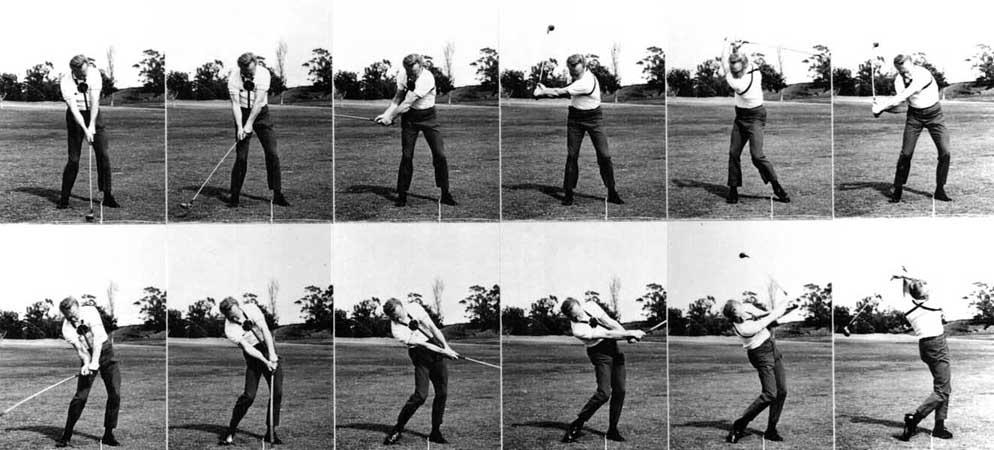
Mike Austin's swing - a photo sequence
His downswing was characterised by a very assertive left-lateral pelvic shift-rotation move, that created a large degree of secondary axis tilt. He had a perfect kinetic sequence, and his downswing started optimally with a lower body shift-rotation move, followed by an upper torso rotational move. His left arm was subsequently released in the mid-late downswing as a result of his pivot-drive action (release of PA#4), and the release of PA#4 was followed shortly thereafter by the centrifugal-induced release of PA#2. He used a right arm throw action that allowed his right arm to move in perfect synchrony with his left arm, so that it helped him to synergistically maximise clubhead speed at impact. His inordinate degree of spinal flexibility allowed him to retain a remarkable amount of secondary axis tilt well into the followthrough phase of his swing, and that allowed him to remain in balance despite a very fast swing action and considerable clubhead momentum through impact. He kept his head, and therefore upper swing center, stationary throughout the donwswing and followthrough, which allowed him to generate a consistent clubhead arc and a consistent low point location. His downswing action was ultra-smooth and his fluid downswing action flowed without any hiccups into an equally fluid finish action.I think that Mike Austin is a perfect role model for long-drive competitors, and I would highly recommend his swing style for flexible golfers who want to maximise their swing power and driving distance. Mike Dunaway has done an excellent job describing Mike Austin's swing methodology in his DVD [3], and I would definitely recommend that DVD to golfers who want to learn more about Mike Austin's swing methodology.
Jeffrey Mann.
May 2010.
References:
1. Wikipedia - Mike Austin (golfer).http://en.wikipedia.org/wiki/Mike_Austin_%28golfer%29
2. Mike Austin's 515 yard drive.
http://www.beauproductions.com/golfswingsws/mikeaustin/main.htm
3. 515 Yards! Mike Austin's Secrets Fron the Game's Longest Hitter. Mike Dunaway.
DVD is available from http://www.peacerivergolf.com
4. The Mike Austin Method - How to Kill the Ball. Dan Shauger.
5. The Golfing Machine. Homer Kelley.
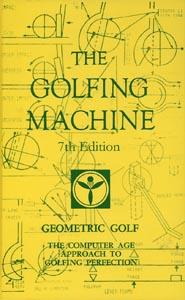
6. Mike Austin swing videos on U-tube.a. http://www.youtube.com/watch?v=ox7dWtlMwe4
b. http://www.youtube.com/watch?v=OzUskvpZ9Rw
c. http://www.youtube.com/watch?v=nYN7xWLnjoo
d. http://www.youtube.com/watch?v=zc5ufM1MW1o
e. http://www.youtube.com/watch?v=IoqZufP3UJc
f. http://www.youtube.com/watch?v=UdpoU1LA2os
g. http://www.youtube.com/watch?v=s1EOt-RQO2g
7. Mike Austin golf forum discussion thread.http://www.mikeaustingolf.com/phpBB2/viewtopic.php?t=816
8. Jaacob Bowden's comments on Mike Austin's hand action.http://www.jaacobbowden.com/mikeaustin.html
9. The 7 Laws of the Golf Swing. Nick Bradley.

